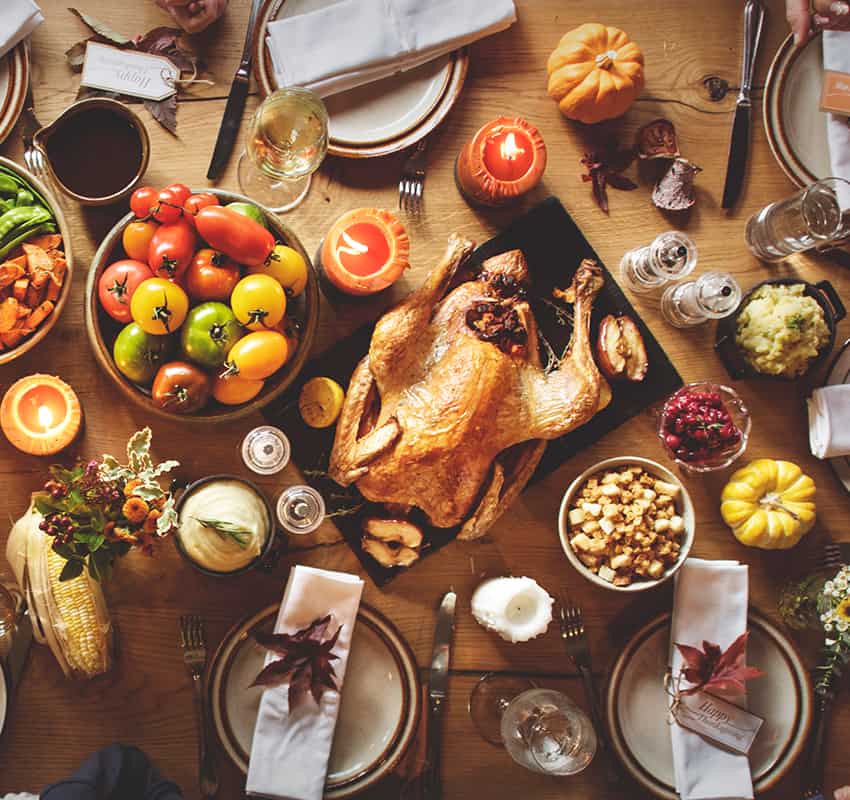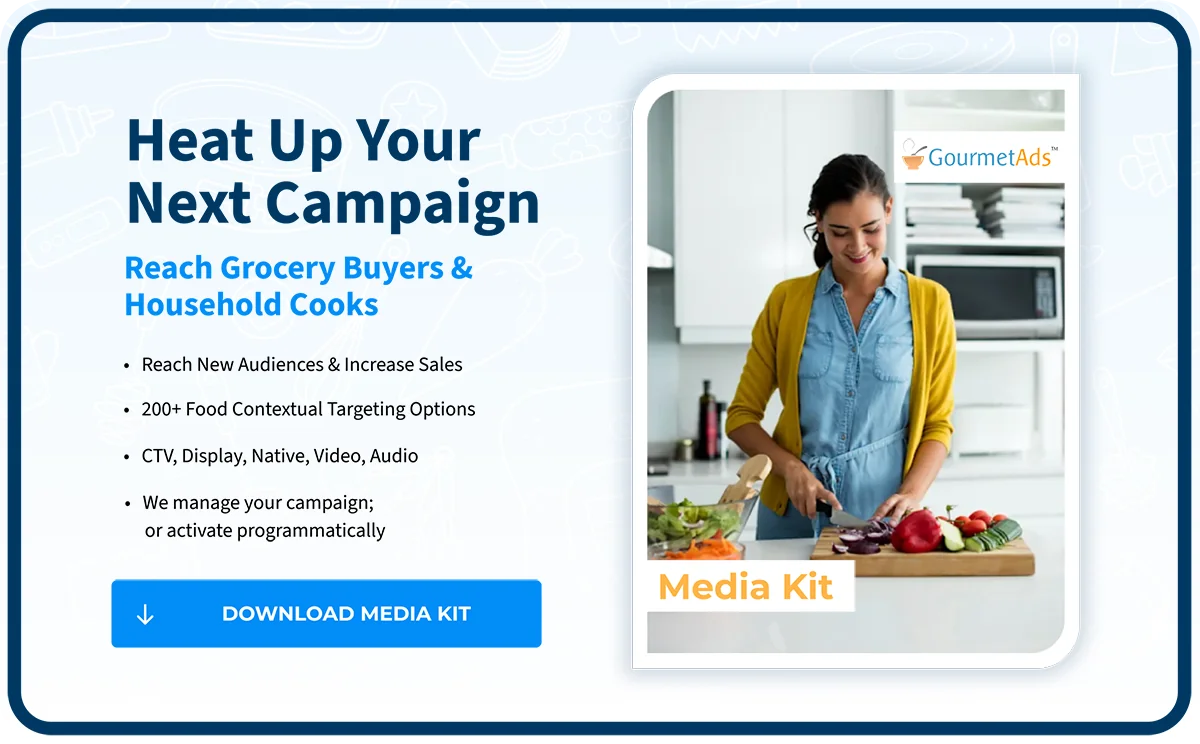Thanksgiving Advertising
In the USA, Thanksgiving is the biggest holiday of the year in the for those who create online recipe content. Come late November, consumers develop a voracious hunger for food-related ideas and instruction. There is no doubt that search volume for recipes doubles during the week of Thanksgiving, and brands wanting a presence alongside the hottest content of the holiday, therefore, know that food websites are where they’ll need to be.
Thanksgiving Advertising Strategies & Targeting
From a Media Planning and Buying perspective, Gourmet Ads recommends for brands wanting to engage and influence Grocery Buyers using Contextual Targeting for their Thanksgiving Advertising Campaign.
Thanksgiving Contextual Targeting
- Thanksgiving Recipes
- Side Dish Recipes
- Turkey Recipes
- Holiday Recipes
- Baking Recipes
- Stuffing Recipes
Thanksgiving Audience Segments
These segments can be used uncoupled in your own DSP
- Thanksgiving Holiday Cooks
- Holiday Cooks
- Grocery Buyers
- Household Cooks
- Recipe Content
Thanksgiving Campaign Options
- Programmatic Advertising via Deal ID / PMP
- Curated Deals
- Managed Services
Thanksgiving Dates
- 2023 – 23rd November
- 2024 – 28th November
- 2025 – 27th November
- 2026 – 26th November
- 2027 – 25th November
The Thanksgiving Advertising Timeline
Based on tracking of historical Thanksgiving search data and other consumer behaviors, here’s a primer for planning your brand’s Thanksgiving advertising campaign.
- Two Months Before Thanksgiving: The search for Thanksgiving recipes starts two months in advance, in early September. While main dishes may be locked down in many families, recipes for new sides as well as those for dessert options are in high demand.
- The Week Before Thanksgiving: Thanksgiving-related search volume kicks into high gear as dish decisions are locked in, and shopping begins. Those not hosting Thanksgiving celebrations may be on the hunt for sweet and savory dishes to add to the table they’ll be welcomed to.
- Thanksgiving Day: The holiday has arrived, but your consumers still need information. Expect to find them, smartphone in hand, searching for recipes and food-related content as they cook and set the table. Thanksgiving-related searches actually hit their high today. So, campaigns should be scheduled to allow for brand presence when consumers are searching for last-minute help. Some sites, for instance, target recipe content around such day-of challenges as finding out that an expected guest is a vegan, or that a family member has been diagnosed as gluten intolerant.
- Three Days after Thanksgiving: This is when search volume for Thanksgiving leftover recipes hits its annual high. In recent years, brands have found engagement success promoting their own ideas for repurposing leftovers. Food bloggers can also be counted on to engage readers surrounding topics such as the best post-Thanksgiving sandwiches or turning leftovers into healthy meal-prep ingredients.
- The Following Week: Once the leftovers are consumed, the focus of recipe searches turns swiftly to cookies. In fact, a quarter of all searches for cookie recipes will take place in December.
A Brief History of Thanksgiving Advertising
It wasn’t too long ago, however, that brand marketers were inspiring consumers’ Thanksgiving behaviors, rather than reacting to it. Advertising helped to create–and maintain–many of the traditions we now think of as a permanent part of our turkey-day rituals.
The Rise of Turkey
Iowa State University marketing professor Samantha N. N. Cross took a deep dive into 99 years of Thanksgiving ads that ran in Good Housekeeping. After the turn of the century, Cross found, magazine ads showed that turkey had not yet been crowned king of Thanksgiving. Ads promoting duck, chicken or goose as Thanksgiving’s star appeared alongside those for turkey. Turkey’s messaging won out, though, and in Good Housekeeping issues from 1920 and later Cross found that turkey was the only Thanksgiving meat advertised. Today, 20 percent of the turkeys that will be eaten all year are consumed at Thanksgiving.
Pumpkin pie seems to have secured its place on the Thanksgiving table thanks to brand marketers, as well. While it wouldn’t have been served at the first Thanksgiving, by 1925 Cross found that brands like Libby’s and Mrs. Smith’s were running advertisements to convince hostesses that pumpkin pie was the quintessential dessert of the holiday. Cranberries inserted themselves into the holiday in a similar manner, Cross found. Grape juice and walnuts made their own attempts, however they were unsuccessful in their similar efforts.
Modern Thanksgiving Behavior
These Thanksgiving foods are firmly entrenched as part of the holiday’s traditions, today. But certain consumer behaviors continue to change year-over-year. When, and how, home cooks will shop for the Thanksgiving meal continues to evolve. And the methods consumers will use to find the recipes they’ll use is also changing. The prevalence and depth of consumer behavior data now allows brands to react to each of these behavior shifts. Surely the ad agencies who created the Good Housekeeping ads that Cross studied would envy how clear a behavioral picture brands now have.
The Next Thanksgiving Behavior Changes
The next round of Thanksgiving behavior changes that brands will keep a keen eye on are likely to surround the use of mobile devices. Its estimated that 44 percent of people will use their mobile device to search for Thanksgiving recipes, 78 percent of Millennials will use their smartphone to aid in their holiday grocery shopping, and 70 percent will use their smartphone to aid their holiday cooking. And consumers are increasingly using their phones to buy food for their holiday meals, according to Comscore. They predict continued growth in mobile purchases of food and beverage for the holiday season.
Let’s Get Started !
Let the Gourmet Ads team walk you through all the options available to ensure that your Food, Supermarket, Beverage or Kitchen advertising campaign has the best possible combination of Premium Guaranteed Inventory, Scale, First Party Data, Contextual Targeting and Programmatic Advertising elements.







